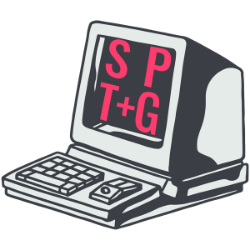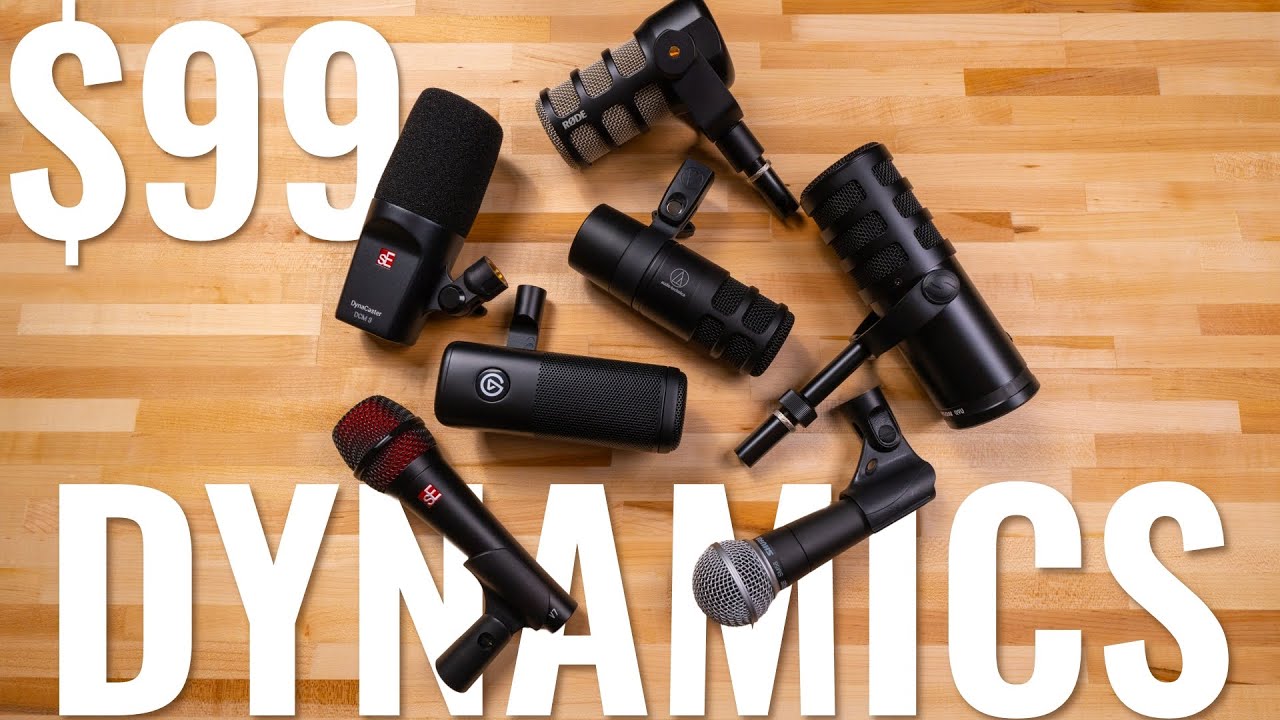Links in this post may be affiliate links. Any products purchased through affiliate links may provide a small commission which helps to support the SemiPro Tech+Gear site and YouTube channel.
In recent years, manufacturers have flooded the market with $99 dynamic microphones, and many (if not all) of them have been targeted towards podcasters and streamers. Are they a step up in quality from budget microphones worthy of the price tag? Let’s compare seven options, some old and some new. Watch the video comparison below for audio samples.
Looking for the best podcasting microphones at all budget levels? Check out my top recommendations.
1. Shure SM58

Polar Pattern: Cardioid
Freq Response: 50Hz – 15kHz
Sensitivity: -56 dBV
Output: XLR
Features/Switches: None
The SM58 is the most tenured microphone in this comparison, being produced since 1966 and used by countless live performers. It has become a standard baseline to measure other dynamic microphones in the price range, so it only felt right to include it in this comparison. Being a handheld dynamic, the SM58 can handle a little bumping around without amplifying too much into your recording. As far as sound quality and performance for podcasting, streaming, and content creation, the SM58 feels very “middle of the road” to me. It’s got a relatively bright sound profile but not overly so. It doesn’t set the high bar but also provides very usable sound. The SM58 definitely can benefit from a pop filter or windscreen due to poor plosive rejection.
2. Rode Podmic

Polar Pattern: Cardioid
Freq Response: 20Hz – 20kHz
Sensitivity: -57 dBV
Output: XLR
Features/Switches: None
The Rode Podmic has become a standard option for podcasters, streamers, and content creators since its release in 2018. The Podmic gets many things right for the price tag. Construction quality is the best in this comparison, and it has a low-end rolloff in the frequency response that works like a built-in high-pass filter preventing too much rumble from things like bumping the desk or boom or heavy-handed typing on a keyboard. However that can also mean the Podmic sounds a little thin in the low end compared to other microphones, though a little boost around 100Hz in post will warm it up and give a little more balance to the upper-mid forward sound. It’s approaching SM7B territory in sensitivity, meaning it needs a good bit of gain to get a good recording level.
3. sE Electronics V7

Polar Pattern: Supercardioid
Freq Response: 40Hz – 19kHz
Sensitivity: -54 dBV
Output: XLR
Features/Switches: None
If you prefer the fuller sound of the SM58 but want something a little smoother, the sE V7 is worth a look. It has a more full sound than the Podmic while also being ever so slightly less bright than the SM58, and nice all-metal build quality. It also doesn’t weigh a ton or take up a lot of space, making it more travel-friendly. The supercardioid polar pattern allowed it to pick up a bit less of the background noise from a computer fan in the comparison test as well.
4. Audio-Technica AT2040

Polar Pattern: Hypercardioid
Freq Response: 80Hz – 16kHz
Sensitivity: -53 dBV
Output: XLR
Features/Switches: Non
The AT2040 from Audio-Technica is intended to be a budget-friendly option for content creators if the $349 BP40 is a bit out of reach. Audio-Technica provided a nice build quality and effective internal shock absorption, but a slightly unnatural sound quality in my opinion. The relatively narrow frequency response (compared to most competitors) is supposed to help cut out unwanted frequencies, but somehow I still hear some desk rumble in the keyboard typing test and when heard back to back with others in this comparison, I preferred the sound of most competitors over the 2040. It has the second-highest sensitivity in this comparison, which means you don’t need high-gain preamps to drive it – a Focusrite Scarlett will do just fine without a signal booster.
5. Elgato Wave DX

Polar Pattern: Cardioid
Freq Response: 50Hz – 15kHz
Sensitivity: -52 dBV
Output: XLR
Features/Switches: None
The Wave DX landed somewhere in the middle of the pack for me. Although the construction is mostly metal, it feels relatively lightweight to me and just doesn’t have that “bombproof” feel like the Podmic. The sound quality to me comes across as mostly natural with a little bit too much of a bass frequency rolloff, but that does help to mitigate against desk and keyboard rumble. It also performed the best for plosive rejection (though you still should try to talk past it rather than directly into it). The Wave DX is tied for the highest sensitivity in the comparison, allowing you to use pretty much any interface preamp on the market that offers 50+ dB of gain without a signal booster.
6. sE Electronics DCM3

Polar Pattern: Cardioid
Freq Response: 40Hz – 18kHz
Sensitivity: -52 dBV
Output: XLR
Features/Switches: None
I found the DCM3 to be quite pleasant in the comparison, sounding more natural and full compared to the Wave DX and AT2040. I did, however, feel that the high frequencies are a bit harsh at least on my voice. Interestingly, sE also offers a model with a built-in signal booster, the DCM6 for $149. However, the DCM3 is already tied for the highest sensitivity in this comparison at -52 dBV. In my opinion, you can save yourself the $50 as long as you don’t have a super-low powered preamp in your interface or mixer. What would make the DCM6 worth it? If you record using a device like a Zoom H4n or Tascam DR-40x, they have somewhat noisy and lower-powered preamps that don’t perform well with most dynamic microphones unless you have a signal booster. But if you’re using one of the many capable audio interfaces on the market with 50dB or more of gain, you’ll be fine with the DCM3.
7. Samson Q9U

Polar Pattern: Cardioid
Freq Response: 50Hz – 20kHz
Sensitivity: -57 dBV (XLR)
Output: XLR, USB-C
Features/Switches: HPF, Mid-Boost, Mute Button
The Samson Q9U is the only microphone in this comparison that did more than just the bare minimum. However I should mention that Samson still indicates the MSRP of the Q9U is $199 even though it has been available from retailers for $99 for quite a while. The Q9U includes a USB-C output giving you the option to connect directly to a computer, tablet, or smartphone, a mute button that works in both USB and XLR modes, and high-pass and mid-boost switches. Samson even included an internal feature lacking in every other microphone in this comparison: a humbucking coil. I could (and probably will) write a whole separate article about this. The short version is: humbucking coils help to reduce environmental hum or buzz such as A/C current hum that dynamic microphones can otherwise amplify to an audible level in your recording.
The Q9U also holds the designation of being the only microphone in this comparison that sounds truly “different”. Instead of the brighter sound profile that is common among microphones in this category, Samson went for a darker tone that doesn’t highlight sibiliance or sound over-boosted in the high frequencies. Unfortunately, my personal impression of the sound is that they overshot the goal and went into somewhat dull-sounding territory that actually needs some brightening-up. The mid-boost switch provided a preferable sound for my voice, so that was a nice feature to have.
After watching the video above, do you think any of these options are worth the $99 price tag? Leave a comment below!


